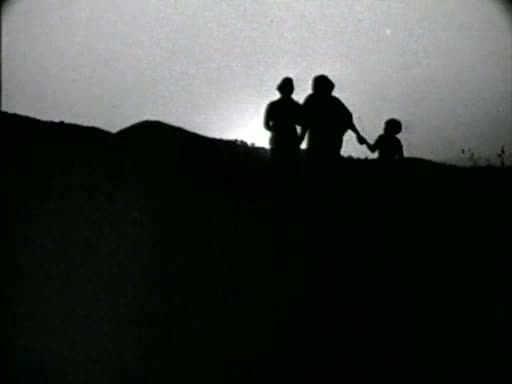
Josef von Sternberg's debut film, The Salvation Hunters, immediately gained him a reputation as a filmmaker worth watching and catapulted him to a position in Hollywood, even though this hour-long experimental project, shot by von Sternberg himself on a low budget in real locations, was anything but commercial. Purely by luck, the film got the attention of stars Charles Chaplin, Douglas Fairbanks and Mary Pickford, and the young filmmaker would soon become a Hollywood director. In this debut, the themes and aesthetics that would weave throughout the remainder of von Sternberg's career are already readily apparent in nascent form. The opening scenes, with various losers and lost souls aimlessly hanging around on the docks, would be echoed in the later classic The Docks of New York, and more generally the moody, melancholy atmosphere of this film proves that the director's aesthetic was fairly well-formed right from the beginning of his career.
The film is a loose, nearly plotless study of a trio of outcasts who number among "the derelicts of the earth," to whom von Sternberg dedicates the film in the text-heavy introduction. The film announces right up front that it's not about narrative but about attempting to photograph "a thought," and its minimal story concerns broadly defined types rather than specific characters, because what von Sternberg is really exploring is not a story happening to particular people but a universal state of being, a universal set of emotions. The characters aren't even named, they're just identified as a boy (George K. Arthur), a girl (Georgia Hale), and a child (Bruce Guerin), who together form a de facto family, united in their loneliness and their downtrodden existence. They're miserable and alone at the docks, surrounded by mud and garbage — von Sternberg captures the atmosphere of the docks so well, in closeups of rotting fish and junk barges, that one can practically smell it — so they decide to go to the city, but find that things are no better there.
The film's story is minimal, but its photography is gorgeous and haunting, and even in this first amateur work, it's steeped in von Sternberg's raw stylized emotionalism. Despite this, it seems obvious that the inexperienced young filmmaker was not yet confident enough in his visuals to let them drive the film, and the film is saddled with overbearing, pompous, self-consciously literary text scattered throughout its copious title cards. The writing drags the film down, explicitly identifying visual symbols — at one point, a title spells out that a mud-dredging claw was "a symbol of the boy's faith... that all mud could be brought up into the sun" — and hammering home the themes without the subtlety and ambiguity that would always characterize von Sternberg's subsequent films. It's a mark of insecurity; von Sternberg clearly knew what he wanted to say in this very personal debut, and though he says it very well in pure visual terms, he seemingly wanted to make sure that his message was not missed. It's unfortunate, and the constant barrage of text breaks up the flow of the images, marring the visual poetry.

This problematic wordiness aside, The Salvation Hunters is evocative and potent, and it's easy to see why it was such a hit with film artists like Chaplin and Fairbanks, if not with general audiences. Chaplin was so impressed by the film that not only did he help bring von Sternberg to Hollywood, but he immediately cast Georgia Hale as the bad girl love interest in his own masterpiece The Gold Rush, made later the same year. The Salvation Hunters itself has hints of Chaplin's influence on von Sternberg, especially in the scenes of sentimental comedy featuring the kid, a very Chaplinesque type whose sporadic antics infuse the film with an energy that's certainly not found in the downtrodden older leads.
Hale's performance, in particular, is intensely sad, her mouth permanently twisted into a frown, her eyes heavily lidded so that she seems to be staring at the world through thin slits, a cigarette lazily drooping from her lips — "good girls don't smoke," the boy tells her, taking her cigarette, and she promptly grabs it right back and resumes sullenly smoking. In one scene, she sees a dock bully get splashed with muck on a garbage barge, and she laughs for a moment before she suddenly seems to remember herself and forces her expression back to its sneering scowl. It's a focused performance of pure malice and depression, set off against Arthur's weak-willed everyman, who needs to overcome his cowardice and weakness and journey from "the mud" to "the sun."
The journey is blatantly symbolic, but what's interesting is that von Sternberg also grounds the film in a gritty, realistic depiction of the cruelties of the world. Though their story is couched abstractly in terms of "mud" and "sun," this downtrodden trio encounters all too real violence and corruption, with monstrous bullies who beat the kid and a slimy pimp who circles around the girl, trying to starve or seduce her into prostitution. That tension between expressionist, abstract symbolism and seedy realism would perhaps be more cleanly resolved in von Sternberg's later films, but here in its raw form it's still a potent combination. The Salvation Hunters is an excellent debut in general, still marked by the flaws and weaknesses that the director would smooth out with more confidence, but pictorially striking and wonderfully atmospheric.

1 comment:
A "Sundance Film" eons before "Sundance."
It's a gem.
Post a Comment